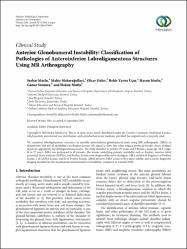Anterior glenohumeral instability: Classification of pathologies of anteroinferior labroligamentous structures using MR arthrography

Göster/
Erişim
info:eu-repo/semantics/openAccessTarih
2013Yazar
Mutlu, SerhatMahiroğulları, Mahir
Güler, Olcay
Uçar, Bekir Yavuz
Mutlu, Harun
Sönmez, Güner
Mutlu, Hakan
Üst veri
Tüm öğe kaydını gösterKünye
Mutlu, S., Mahiroğulları, M., Güler, O., Uçar, B. Y., Mutlu, H., Sönmez, G. ... Mutlu, H. (2013). Anterior glenohumeral instability: Classification of pathologies of anteroinferior labroligamentous structures using MR arthrography. Advances in Orthopedics, 2013. http://dx.doi.org/10.1155/2013/473194Özet
We examined labroligamentous structures in unstable anteroinferior glenohumeral joints using MR arthrography (MRA) to demonstrate that not all instabilities are Bankart lesions. We aimed to show that other surgical protocols besides classic Bankart repair are appropriate for labroligamentous lesions. The study included 35 patients (33 males and 2 females; mean age: 30.2; range: 18 to 57 years). MRA was performed in all patients. The lesions underlying patients’ instability such as Bankart, anterior labral periosteal sleeve avulsion (ALPSA), and Perthes lesions were diagnosed by two radiologists. MRA yielded 16 diagnoses of Bankart lesions, 5 of ALPSA lesions, and 14 of Perthes lesions. Albeit invasive, MRA seems to be a more reliable and accurate diagnostic imaging modality for the classification and treatment of instabilities compared to standard MRI.
Kaynak
Advances in OrthopedicsCilt
2013Koleksiyonlar
- Makale Koleksiyonu [3790]
- PubMed İndeksli Yayınlar Koleksiyonu [4251]
- WoS İndeksli Yayınlar Koleksiyonu [6677]

















